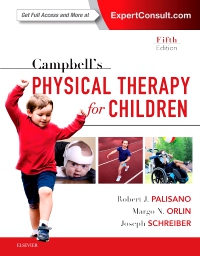
Campbell's Physical Therapy for Children Expert Consult - Pageburst eBook on VitalSource, 5th Edition
Elsevier eBook on VitalSource

Arm your students with all the pediatric physical therapy background and guidance they’ll need with Campbell’s Physical Therapy for Children Expert Consult, 5th Edition. Insightful and comprehensive coverage walks them through all aspects of working with children, including: decision making, screening, development, motor control and motor learning, the impairments of body function and structure, and the PT management of pediatric disorders. Like the previous bestselling editions, this edition also follows the practice pattern categories of the Guide to Physical Therapist Practice and uses the IFC model of the disabling process as it presents up-to-date, evidence-based coverage of treatment. New to this edition are a number of added and extensively revised chapters — covering topics such as tests and measures, autism spectrum disorder, pediatric oncology, and the neonatal intensive care unit — to keep students at the cutting edge of the latest issues and best-practices. Finally, with it’s wealth of online resources and learning aids, they’ll have all the tools and support they need to tackle every aspect of pediatric physical therapy — including passing the APTA’s Pediatric Specialist Certification Examination!
Newer Edition Available
Campbell's Physical Therapy for Children - Elsevier E-Book on VitalSource
-
- NEW! Revised chapter on motor development and control now closely examines the when, how, why, and what of developing motor skill and how it contributes to effective physical therapy
- NEW! Chapter on children with autism spectrum disorder (ASD) covers the characteristics of ASD, the diagnostic process, program planning, and evidence-based decision making for children with ASD
- NEW! Chapter on pediatric oncology addresses the signs and symptoms of pediatric cancers, the most common medical interventions used to treat these diseases, the PT examination, and common therapeutic interventions
- NEW! Chapter on tests and measures guides students on the effective use of tests and measures in pediatric physical therapy practice
- NEW! Extensively revised chapter asthma helps students better understand the pathology of asthma; the primary and secondary impairments of asthma; the impact on a child’s long term health and development; pharmacological management; and more
- NEW! Revised chapter on the neonatal intensive care unite better addresses the role of the physical therapist in the neonatal intensive care unit
- NEW! Expert Consult platform provides a number of enhancements including a fully searchable version of the book, case studies, videos, and more
- NEW! Revised organization now includes background information — such as pathology, pathophysiology, etiology, prognosis and natural evolution, and medical and pharmacologic management — as well as foreground information — such as evidence-based recommendations on physical therapy examination strategies, optimal tests and measurement, interventions, patient/caregiver instruction, and more
- UPDATED! Full color photos and line drawings clearly demonstrates important concepts and clinical conditions students will encounter in practice
- NEW! Additional case studies and videos help students better understand how concepts apply to practice
-
- NEW! Revised chapter on motor development and control now closely examines the when, how, why, and what of developing motor skill and how it contributes to effective physical therapy
- NEW! Chapter on children with autism spectrum disorder (ASD) covers the characteristics of ASD, the diagnostic process, program planning, and evidence-based decision making for children with ASD
- NEW! Chapter on pediatric oncology addresses the signs and symptoms of pediatric cancers, the most common medical interventions used to treat these diseases, the PT examination, and common therapeutic interventions
- NEW! Chapter on tests and measures offers guidance on how to effectively use tests and measures in pediatric physical therapy practice
- NEW! Extensively revised chapter asthma offers more detail on the pathology of asthma; the primary and secondary impairments of asthma; the impact on a child’s long term health and development; pharmacological management; and more
- NEW! Revised chapter on the neonatal intensive care unite better addresses the role of the physical therapist in the neonatal intensive care unit
- UPDATED! Full color photos and line drawings clearly demonstrate important concepts and clinical conditions that will be encountered in practice
- NEW! Expert Consult platform provides a number of enhancements, including a fully searchable version of the book, case studies, videos, and more
- NEW! Revised organization now includes background information — such as pathology, pathophysiology, etiology, prognosis and natural evolution, and medical and pharmacologic management — as well as foreground information — such as evidence-based recommendations on physical therapy examination strategies, optimal tests and measurement, interventions, patient/caregiver instruction, and more
- NEW! Additional case studies and videos illustrate how concepts apply to practice
-
Section 1: Understanding Motor Performance in Children
1. Evidence-Based Decision Making in Pediatric Physical Therapy
2. Tests and Measures
3. Motor Development and Control
4. Motor Learning: Application of Principles to Pediatric Rehabilitation
5. Musculoskeletal Development and Adaptation
6. Physical Fitness during Childhoold and Adolescence
Section 2: Management of Musculoskeletal Conditions
7. Juvenile Idiopathic Arthritis
8. Spinal Conditions
9. Congenital Muscular Torticollis and Cranial Deformation
10. Arthrogryposis Multiplex Congenita
11. Osteogenesis Imperfecta
12. Muscular Dystrophy and Spinal Muscular Atrophy
13. Limb Deficiencies and Amputations
14. Orthopedic Conditions
15. Sports Injuries in Children
Section 3: Management of Neurologic Conditions
16. Developmental Coordination Disorder
17. Children with Motor and Intellectual Disabilities
18. Cerebral Palsy
19. Perinatal Brachial Plexus Injury
20. Spinal Cord Injury
21. Acquired Brain Injuries: Trauma, Near Drowning, and Tumors
22. Myelodyspasia
23. Children with Autism Spectrum Disorder
Section 4: Management of Cardiopulmonary Conditions
24. Children Requiring Long-term Mechanical Ventilation
25. Cystic Fibrosis
26. Asthma: Multisystem Implications
27. Thoracic Surgery (Cardiac)
Section 5: Special Settings and Special Considerations
28. Serving Infants, Toddlers, and Their Families: Early Intervention Services under IDEA
29. The Education Environment
30. Pediatric Oncology
31. The Special Care Nursery
32. Transition to Adulthood for Youth with Disabilities
33. Assistive Technology
34. Development and Analysis of Gait


 as described in our
as described in our 